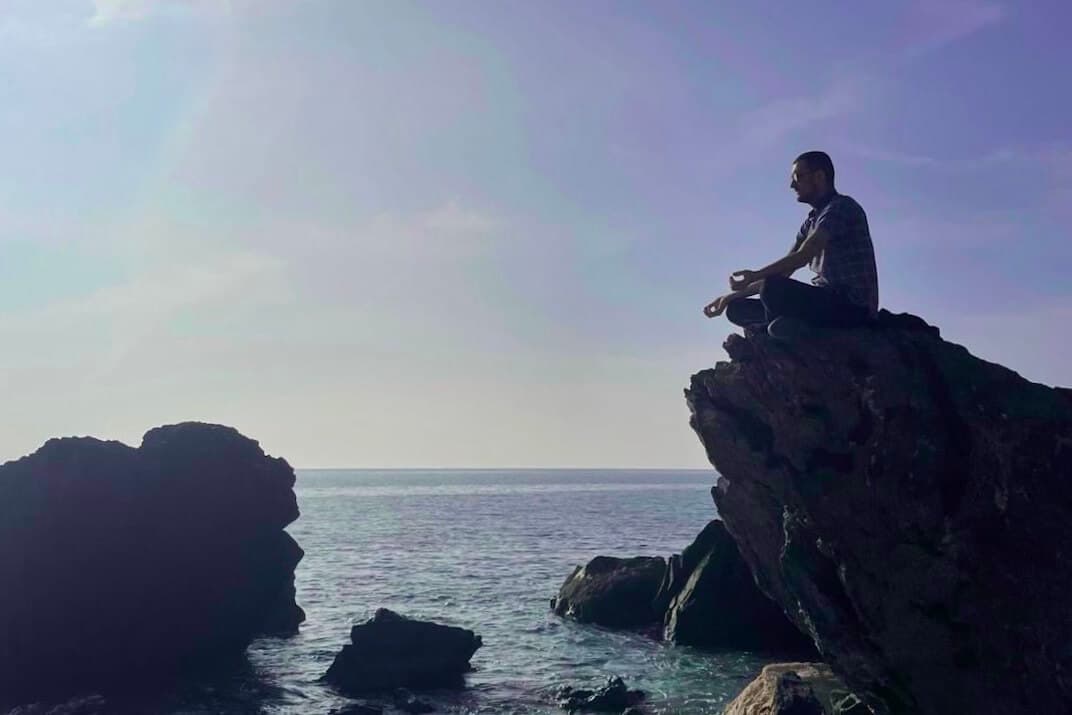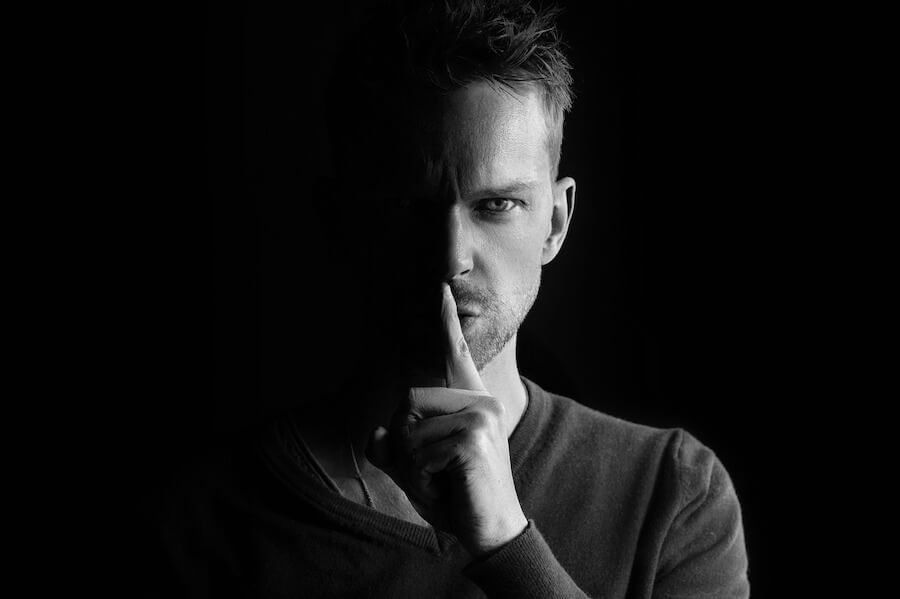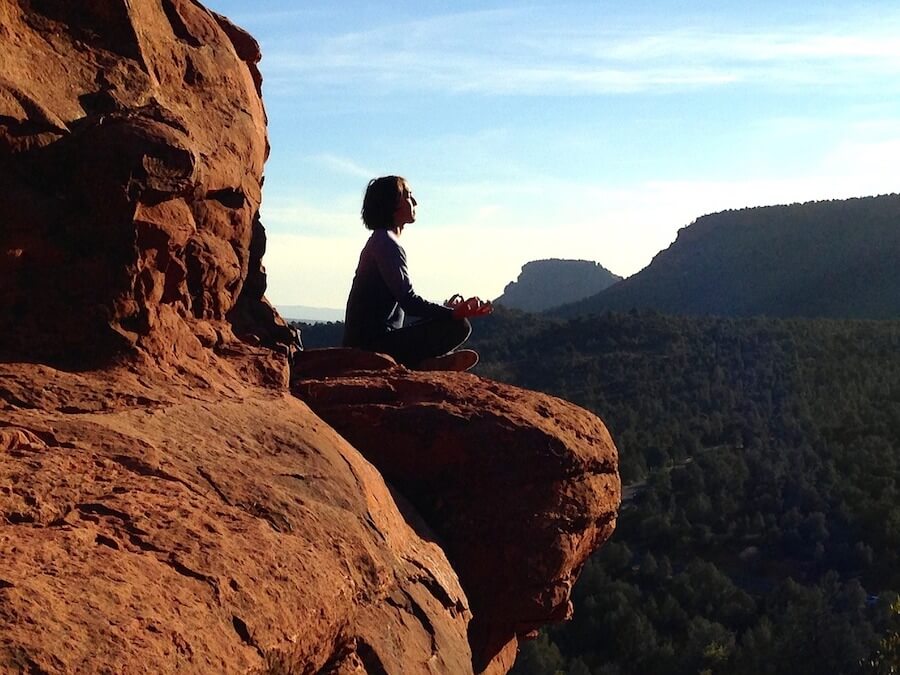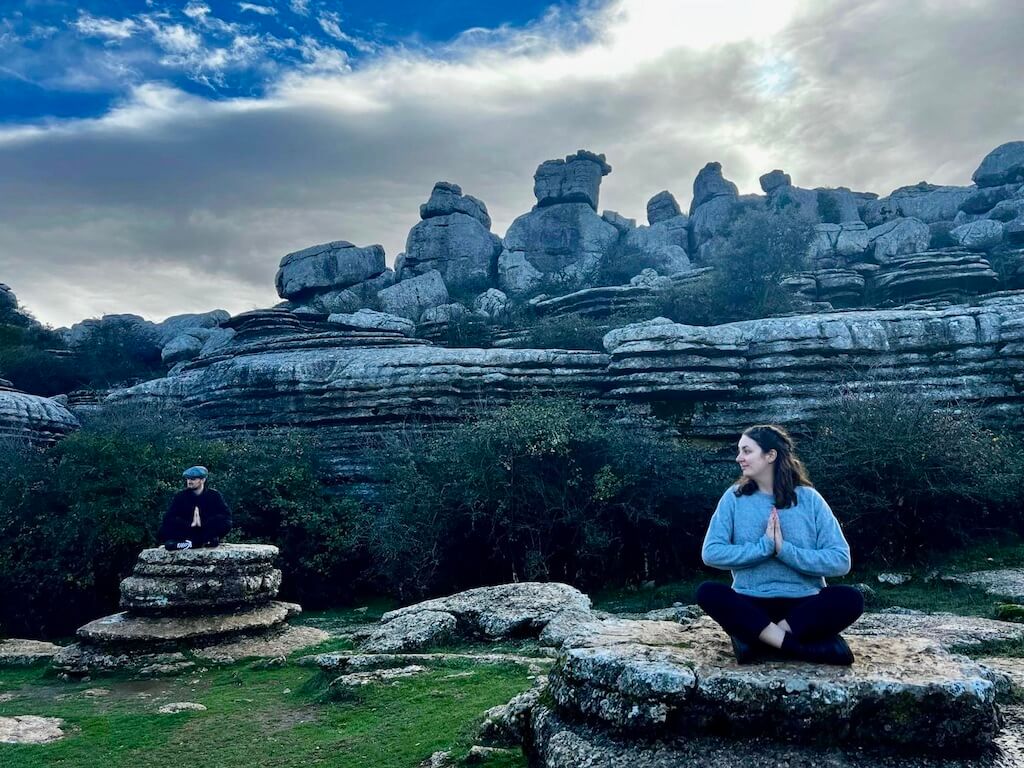Are you familiar with the image of meditation being somebody sitting perfectly still with their eyes closed and looking completely blissful?
I bet you are.
But what about open eyes?
Can you meditate with your eyes open and still reach that state of bliss?
The answer is yes.
You can meditate with your eyes open.
Just as you can meditate in a noisy environment.
So what’s the difference, in effect?
Well, before we delve into meditating with eyes open, let’s take a brief look at what meditation is.
Table of Contents
- What is Meditation?
- What’s the Link Between Meditation and Being Vegan?
- Meditate: Eyes Open or Eyes closed?
- Benefits of Meditating with Eyes Closed
- Benefits of Meditating with Eyes Open
- Why You Should Try Meditating with Your Eyes Open
- Mediate with Eyes Open & then Eyes Closed
- How to Meditate with Your Eyes Open
- Where to Sit to Meditate with Your Eyes Open
- Which Traditions Use Open Eyed Meditation?
What is Meditation?
The verb meditate has two specific meanings listed in the dictionary (reference merriam-webster dictionary).
The first is to contemplate or to ponder, and the second is to practise mental exercises to try to reach a heightened level of spiritual awareness.
But actually, despite its literal definition, when you say the word ‘meditation’, you will conjure up a different image in hundreds of various ways in each person’s mind.
Meditation is a practice which we can describe by its benefits, its goals or its effects, but the way to achieve those, the actual practice you adhere to, is infinitely individual in spite of there being various schools of thought sharing the same methodology.
In fact, there are infinite different ways to practise the process that we call meditation.
Traditional Meditation’s usually portrayed as somebody sitting with their eyes closed, with a look of serenity on their face.
And the majority of people who take up meditation at home will probably adopt this style of meditation.
But meditating with eyes open is also traditional in certain styles of meditation and it brings with it many benefits which can even outrun the closed-eyed version.
But it isn’t a competition and at the end of the day meditation can be practised in many different ways with amazing benefits.
Everybody can transcend limitations and practise meditation to reap the rewards and unlock their true potential.
What’s the Link Between Meditation and Being Vegan?
You may wonder why I write about meditation on a page about vegan lifestyle, but the truth is, (in my opinion!) there’s a great connection between meditating and being vegan, even though not everybody’s going to find it or agree with me.
You see, when you’re deep into the zone, touching the void and sensing the connectedness with all living things, then you realise that the way to obtain peace is to BE peace.
We cannot proclaim to wish for a peaceful world while continuing to support violence, just as we can’t claim to love exercise if we never leave the sofa.
So as you come into the stillness and see that everything we see we create, then you’ll truly change your behaviour, because you won’t want to be the cause of violence anymore.
If you’re looking for some vegan lifestyle hacks for transitioning to vegan or for converting to a whole foods plant based diet, you’ll find it well worth it, and most people say it was the best decision they ever made.
As a benefit, it’s believed that becoming vegan can even enhance the quality of your meditation practice. You may like to take a look at these common vegan FAQ
Meditate: Eyes Open or Eyes closed?
One way to decide between open or closed eyes is to choose what to have as your focus during your meditation.
If you’re focusing on an inner-journey and practising visualisations in your meditation, then you’ll probably find closed eyes easier to do.
If there are a lot of distractions around you, you might also choose to close your eyes. Like if you’re meditating while travelling for example.
You probably choose to close you eyes out of preference for your regular meditation too.
But what about eyes open? When would you do that?
If you’re meditating in the dark, open eyes are easy to practise, as there’s nothing to focus on anyway in all the blackness.
And if you’re focussing on your breathing, really you can choose between the two, trying open eyes for the experience.
One time open eyes wins hands down is when you need to have your eyes open in order to feel secure.
Like if you’re at work for example and closing your eyes would just be too weird.
Benefits of Meditating with Eyes Closed
- Closing your eyes is an instant bio-message to your body to relax.
- You might find you feel closer to your interior world when your eyes are closed.
- There are less visual distractions to attract your attention away from meditation.
- You will be more fully relaxed as you allow your eyelids to drop fully closed.
- It will probably be easier to focus on your breath when your eyes are closed.
- If practising visualisations in your meditation, it’s easier to see your inner screen and the images playing across it if your eyes are closed.
Benefits of Meditating with Eyes Open
- Feeling anxious when you close your eyes is a reality for some people, and if this sounds like you, then keeping your eyes open can be a great way to achieve all the benefits of meditation without the onset of anxiety.
- Closing your eyes can make your mind race, seemingly producing double-speed or double-quantity of thoughts. Keeping your eyes open can help to prevent this reaction when you first take up meditation.
- Meditating with your eyes open makes it possible to meditate in all places, not just perfect meditation locations (think at work, in a shop queue etc).
- Keeping your eyes open can help to reduce the likelihood of you falling asleep during meditation.
- If you’re a beginner, just starting out with meditation, practising with your eyes open may be an easier way to start and could feel less alien than with closed eyes. But it can be the other way round too.
- Open eyed meditation’s great for focus and can help to strengthen your concentration in the face of distractions.
Why You Should Try Meditating with Your Eyes Open
Let’s face it, meditation’s about exploration of self and beyond. And if you only try one type of meditation you’ll never know which is best suited to you.
So there is that as a reason: to try it out and see whether it resonates with you. But that’s an easy answer and there are many more to come!
Even if you’ve always meditated with your eyes closed, it could be a great opportunity for growth to try this different way of meditating.
If you’ve never meditated, sitting down with closed eyes and focussing on OM might seem a little way-out there for you (or not) and if that’s the case, why not just try sitting with eyes open?
For some people, it can be an easier way to start out.
For others, it’s more difficult, but even then it might be worth trying.
Because if it’s difficult for you to reach inner peace with your eyes open, it shows that this practice will strengthen you in an area where you have trouble focussing (namely with distractions).
Meditating with eyes open is a great way to improve your focus in daily life.
So if you struggle to focus when trying to work in a room with external distractions going on, open eyed meditation may well help you to overcome that by increasing your focus.
If you want to specifically practise focus meditation where you stare softly at a something like a candle flame for example, this will obviously need to be done with eyes open.
Another reason for practising meditation with your eyes open is that ultimately we aim to bring our meditative state into our daily life, blending it seamlessly with our action packed day.
And to do this, we need to set aside the period of time for closed eyes, while practising open eyed meditation at all other times.
So if you take a few minutes to meditate and become more mindful just before or after an important meeting with your boss for example, you’ll be able to do that sitting in your normal chair without looking as though you’ve gone to sleep.
In fact, meditating with your eyes open is essential for anybody who integrates mediation into their daily life, not only in allocated slots during the day but also in spontaneous moments throughout the day.
Try experimenting with it and see how you get on.
Mediate with Eyes Open & then Eyes Closed
How to Meditate with Your Eyes Open
Sit comfortably and take a few deep breaths. Inhale fully from the belly up to the chest, then pause for a moment before releasing the breath and expelling all the air from your lungs.
Repeat this a couple of times to fully ground yourself.
Find a spot directly before you but not too far ahead, where you can focus your gaze. Your eyes can be raised to eye level or aimed downwards with the eyelids half closed.
Likewise, the place to you gaze at can be the recommended 5-6 feet away or further if you prefer.
According to Tibeten Buddist tradition, the eyes should be aimed downwards at 45º, as if gazing off the tip of the nose.
You can choose to gaze at anything, like a plant for example, or a spot on the wall, but try not to choose something too intricate.
You don’t want your logical mind to kick in to try to unravel the design.
As you gaze towards the spot, allow your eyes to defocus so that you aren’t really looking at the thing but around it.
Now you can begin your meditation practice in the way you normally would, but with your eyes open.
Some ways to get deep into your meditation with open eyes include . . .
- Focus on your breath with each deep inhale and exhale.
- Repeat a silent mantra such as OM within your mind.
- Sit quietly and observe the thoughts as they drift across your mind, gently releasing them and returning to the stillness.
- Imagine a light starting in your heart chakra, then growing outwards until it is bigger than your entire body and surrounds you, expanding your aura, larger and lager until your energy fills the entire space where you’re meditating.
- Visualise a white light descending from above, entering through the crown of your head and making its way downwards, until your whole body is tingling with the pure energy.
- Light a candle and focus on the flame, returning your focus to the flame every time you find your mind wandering.
Where to Sit to Meditate with Your Eyes Open
Where you meditate obviously depends on the purpose of your meditation practice at any given moment.
If you’re meditating as your time out, main session for the day, then choose a place where you won’t be interrupted or disturbed and where there are as few distractions as possible.
Many people have a favourite room where they go to to meditate, but you can meditate in any spot in your house or even go outside and find a place in nature overlooking a meadow or river for example.
If you’re aiming to integrate meditating into your working day, the place you meditate will have no importance.
Instead, you’re choosing to incorporate meditation into a moment of your day, regardless of where you are.
In this way you can practise meditating in the office, on the bus, or standing in a queue at teh supermarket.
Which Traditions Use Open Eyed Meditation?
Both Tibetan Buddhist and Zen meditation advocate eyes open during meditation.
Modern meditations also use open eyed meditation when you think about it, such as moving meditations, walking, creating art, yoga etc.
If you’ve ever wondered whether or not there’s a wrong way to meditate, I hope this article demonstrates just how diverse the possibilities are.
I hope you will try meditating with your eyes open and go on to discover the world of meditation in the way it best resonates with you.
And remember, if at first it isn’t what you thought, keep going and keep trying new ways until you get the most from your meditation practice.








